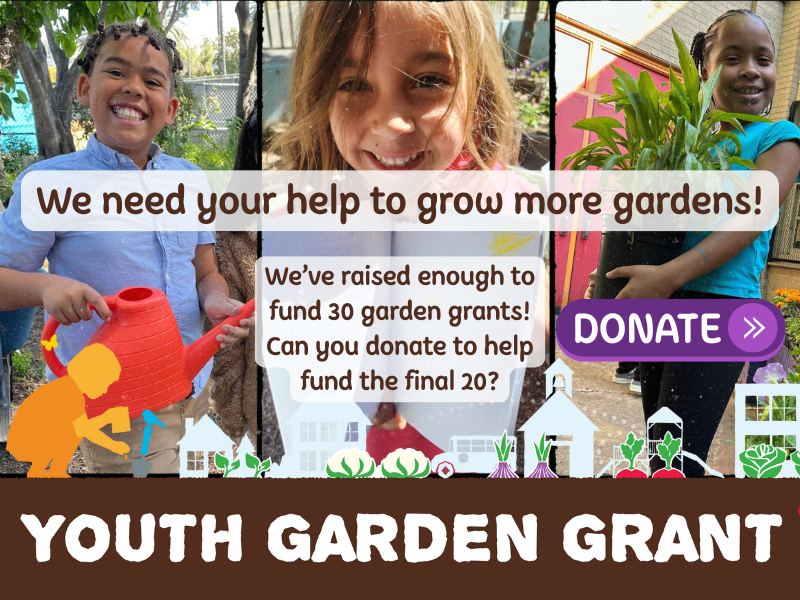Incorporating gameplay into your educational programming or pivoting to a quick game from a planned lesson when the moment calls for it can offer joy, release, and renewed focus for the kids you garden with. We’ve rounded up some fun and physical garden games with the help of our Kids Garden Community members!
Rainbow Races (K-3)
Whenever your garden exhibits a range of colorful flowers, leaves, and fruits, announce that you’re going to observe the rainbow of colors in the garden together with a rainbow race! With each color that you call out, everyone must walk to something alive in the garden that is that color. Emphasize that walking and respecting your neighbor’s space and safety is essential. Then call out, “Everyone walk to something … that is … [INSERT COLOR]!” Allow kids to gleefully race around looking for their preferred plant with each color you call out. Mixing up the order of colors you call out from the traditional ROYGBIV sequence will keep them paying attention instead of anticipating their next destination. Add “multicolor” into the mix if your garden has two-toned flowers or fruits, and add an element of self-expression with “your favorite flower” or “your favorite plant” if time allows. Let kids make as much noise as they like during this exercise to release excess energy and increase their enthusiasm! If kids need a moment to cool off after their races, a garden hose set to the mist-setting and aimed into a sunbeam can offer an actual rainbow to walk through and cool down with. Idea courtesy of Noel N. of Pasadena, CA.
Plant Detectives (K-6)
Let kids use their powers of observation and become garden detectives, hunting around the garden space for different plants, insects, or garden features based on a series of fun clues or riddles. These can be given verbally to the whole group or passed out on worksheets. For example, “Find a plant with spiky leaves, locate a bug that's good for the garden, what looks like a long vine and provides thirsty plants a drink, or I’m an herb you can taste in candy canes, chewing gum, and toothpaste.” Incorporating tools like magnifying glasses, pencils, crayons, and journal paper can add an element of imagination and excitement. Make sure to remind kids that hunting for plants that fit their clues also requires respect for the plants and animals in the garden, and let them know beforehand if picking or eating is okay or not as they explore. Idea courtesy of Mark J. of Redding, CA.
Weeds and Seeds (K-8)
Get kids moving with a variation of the “Red Light Green Light” game. Choose a wide-open location in or near your garden. Have kids stand in a row spaced apart. Across from them, at the distance of your choice, lay a rope/string on the ground and call it the garden. Explain to kids that when you call out “seeds,” they can run toward the rope, and when you call out “weeds,” they have to stop and freeze in place. The first “seed” to the “garden” wins! Idea courtesy of Linda S. of Tonawanda, NY.
Amazing Garden Race (K-12)
Break kids into teams and set up developmentally appropriate tasks at different stations around the school garden. To finish their amazing race, teams need to travel to every station and complete all the tasks. If there are measurable qualities of the tasks, you could make this competitive, i.e., the team to finish the most tasks, the team who makes the finest quality item, etc. However, simply adding an element of set time to complete tasks at each station with a signal to rotate to the next station can create the same excitement and urgency while still allowing every team to experience all the stations and not rush through their work. Stations could be as simple as rotating teams through maintenance tasks like weeding, mulching, watering, etc., or through crafts and educational activities like creating seed balls, a bird nest from fallen materials found in the garden, or sorting a pile of items into compostable and non-compostable categories. Ideas courtesy of Evelyn M. of Sacramento, CA, and Lila M. of AL.
Weed Warriors (3-12)
This game is a fun way to complete garden maintenance while learning to work as a team. Break kids into teams and set a timer for 10 minutes. Have each team work to weed out a defined area within the set time. The winning team will be the one with the greatest quantity pulled within the time limit. Explain to kids that the whole weed, including the root, must be removed, and point out which plants were purposefully planted and need to be avoided. Examining each team's pulled weeds before composting them offers an excellent opportunity to identify and compare/contrast the plants and their parts. It offers a great occasion to talk with kids about cover crops, companion planting, and the idea that some “weeds” or plants that travel to your garden on their own can be left in the soil to benefit the plants you put there yourselves. Extra points can be awarded for the longest weed, widest weed, most unusual weed, most pernicious (and thus, most needed to be removed) weed, etc. Idea courtesy of Erin H. of Plano, TX.



